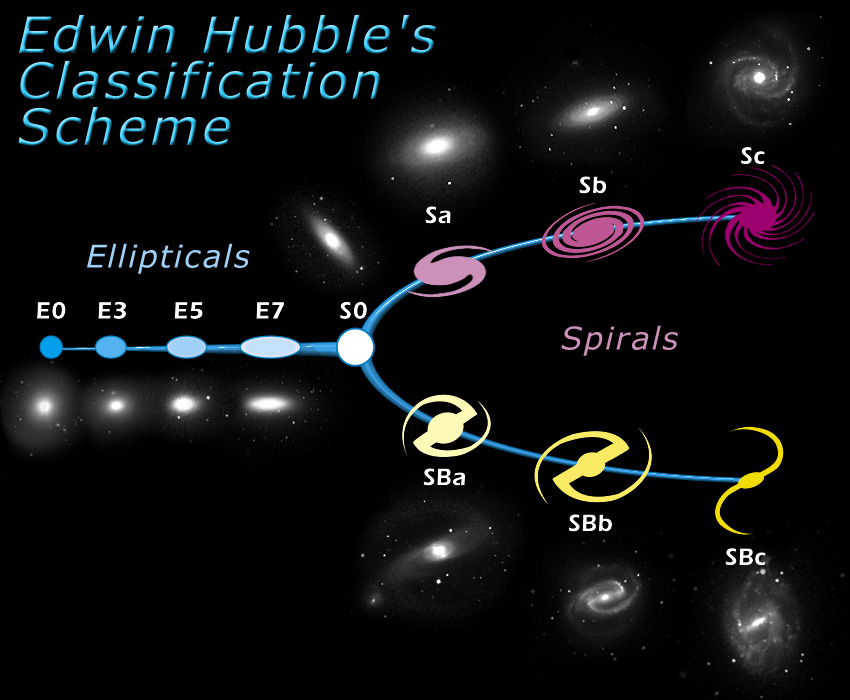Como é constituída uma galáxia?
Uma galáxia é um conjunto de milhões (as anãs) a milhares de milhões (as maiores) de estrelas, gás e poeira. Para além das diferenças em tamanho/massa, entre as maiores, existem diferenças claras morfológicas classificadas pela primeira vez por Hubble. Ainda hoje utilizamos este chamado "diagrama em diapasão de Hubble" (Tuning Fork Diagram).

Diagrama em diapasão de Hubble / Hubble's Tuning Fork Diagram.
(http://cas.sdss.org/runs/en/proj/basic/galaxies/tuningfork.asp)
O tipo de galáxia mais abundante do Universo é como a nossa: uma galáxia espiral (S). Têm muito gás e poeiras, podem ter uma barra estelar central (SB) e, mais importante, têm rotação, pelo que a sua matéria visível está concentrada num disco e apresentam braços em espiral. A matéria invisível ou escura, que ainda não sabemos o que é, domina a massa das galáxias (espirais e outras) e, no caso das espirais, concentra-se num halo esférico.
Quanto às galáxias elípticas (E) são totalmente desprovidas de gás e poeiras, só compostas por estrelas velhas. São semelhantes a enxames de abelhas, com as estrelas a efectuarem movimentos caóticos. O aspecto global é o de um elipsóide: uma forma oval.
Entre as elípticas e as espirais, em morfologia e em composição, existem as galáxias esferóides (S0) que, por acaso, também podem ter uma barra estelar central (SB0). Têm algum gás e poeiras mas, de resto, são em tudo semelhantes às elípticas. Existem outros dois tipos que, em conjunto, não ultrapassam os 5% de todas as galáxias: irregulares (Irr) e peculiares (Pec).
What is a galaxy made of?
A galaxy is a set of millions to billions of stars, dust and gas. Beyond the differences in size/mass, among the biggest there are clear morphological differences classified for the first time by Hubble. We still use the called the Hubble "Tuning Fork Diagram" (see Figure).
The most abundant type of galaxy in the Universe is like ours: a spiral galaxy (S). They have a lot of gas and dust, they may have a central stellar bar (SB) and, most importantly, they rotate, so their visible matter is concentrated on a disk, and they have spiral arms. "Invisible" or "dark" matter, which we still don't know what it is, dominates the mass of galaxies (spiral and others) and, in the case of spirals, is concentrated in a spherical halo.
As for the elliptical galaxies (E), they are totally devoid of gas and dust, only composed of old stars. They are similar to swarms of bees, with the stars performing chaotic movements. The overall appearance is that of an ellipsoid: an oval shape.
Between the ellipticals and the spirals, in morphology and composition, there are the spheroid galaxies (S0) which, by chance, may also have a central stellar bar (SB0). They have some gas and dust but are otherwise similar to ellipticals. There are two other types that, together, do not exceed 5% of all galaxies: irregular (Irr) and peculiar (Pec).
